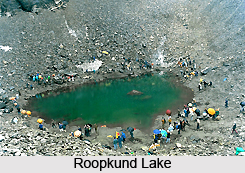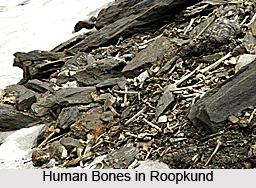 Roopkund is a good mystery, but is loved by everyone but for some, unravelling mystery is everything. With all, Roopkund Lake becomes the place of mystic beauty.
Roopkund is a good mystery, but is loved by everyone but for some, unravelling mystery is everything. With all, Roopkund Lake becomes the place of mystic beauty.
Roopkund is one of the most captivate and adventure absorbing paradigm of mysterious places getting unravelled. Roopkund Lake in Uttarakhand cuddles in the isolated wombs of the majestic Middle Himalayan Region at a height of 5029 meters above sea level.
Roopkund is also popularly known as Skeleton Lake. The lake is nestled in a valley with steep sides and no one can inhabit in this area, even passing through the area can prove lethal for normal human beings. Roopkund in Uttrakhand has a mystique and ambiguity that has kept in deception in multiple generations of fortune tellers.
 Roopkund Lake is the frozen lake. It glorifies the beauty of the Himalayan Mountain range with a mystery that is really hard to decode. For months this shallow lake is frozen. Roopkund Lake is beautiful but there is also some frightening feel in this nearly lifeless place.
Roopkund Lake is the frozen lake. It glorifies the beauty of the Himalayan Mountain range with a mystery that is really hard to decode. For months this shallow lake is frozen. Roopkund Lake is beautiful but there is also some frightening feel in this nearly lifeless place.
Legends of Roopkund
The first written reports appear in 1898, during the rule of British Empire in India. In 1942, a British forest guard in Roopkund made a discovery. Some 16,000 feet above sea level, at the bottom of a small valley, there was a frozen lake absolutely full of skeletons. That summer, the ice melting revealed even more skeletal remains, floating in the water and lying haphazardly around the lake`s edges. The immediate supposition was that these were the remains of Japanese soldiers who had died of exposure while sneaking through India. The British government, anxious of a Japanese land invasion, sent a team of investigators to decide if this was true. However upon examination they realized these bones were not from Japanese soldiers. It was evident at that time, that the bones were quite old indeed. The low temperature, rarefied and fresh air helped to conserve the bodies of deceased better than it would happen elsewhere. Flesh, hair, and the bones themselves had been preserved by the dry, cold air, but no one could properly determine exactly where they were from. Through carbon dating tests, it has been experimentally estimated that these skeletons belong to anytime between 12th and 15th century. It is primarily believed that the deaths were caused by some kind of natural disaster like a blizzard, landslide or any viral disease. In the year 2004, the Indian anthropologists unearthed the fact that these are the archaeological treasures like well-preserved corpses, jewellery, bones and skulls belonging to the dead.
History of Roopkund
A king of Kannauj, in North India, ancient land of south from Gharval Himalaya, Jasdhawal was on a pilgrimage to praise the Goddess Nanda Devi. Somehow he disregarded advice of religious counsellors and behaved in an arrogant way. The king took all his entourage with him including numerous dancer girls, musicians, servants. Also his pregnant wife was with him. As they reached Roopkund, the wife of sovereign ruler delivered a child in a cave near the lake. The goddess Nanda Devi disliked that dancers and musicians entered her sacred land. But the worst violation was childbirth on sacred land. According to local customs in Uttarakhand, the newborn and their mothers are considered to be unclean for certain period of time. Thus Goddess Nanda Devi sent a terrible storm on poor pilgrims and they all were killed. This legend is well known in Himalaya and there is even traditional song mentioning this event - this song mentions exactly hailstones "hard as iron" raining on the heads of sinners.
Visiting Information
Roopkund is accessible through the road ways. However, most of the trekkers and adventure travellers travel to Lohajung or Wan by road. From there they reach "Ran ki dhar" by climbing a hillock at Wan. Then one needs to reach Roopkund by walking.



















